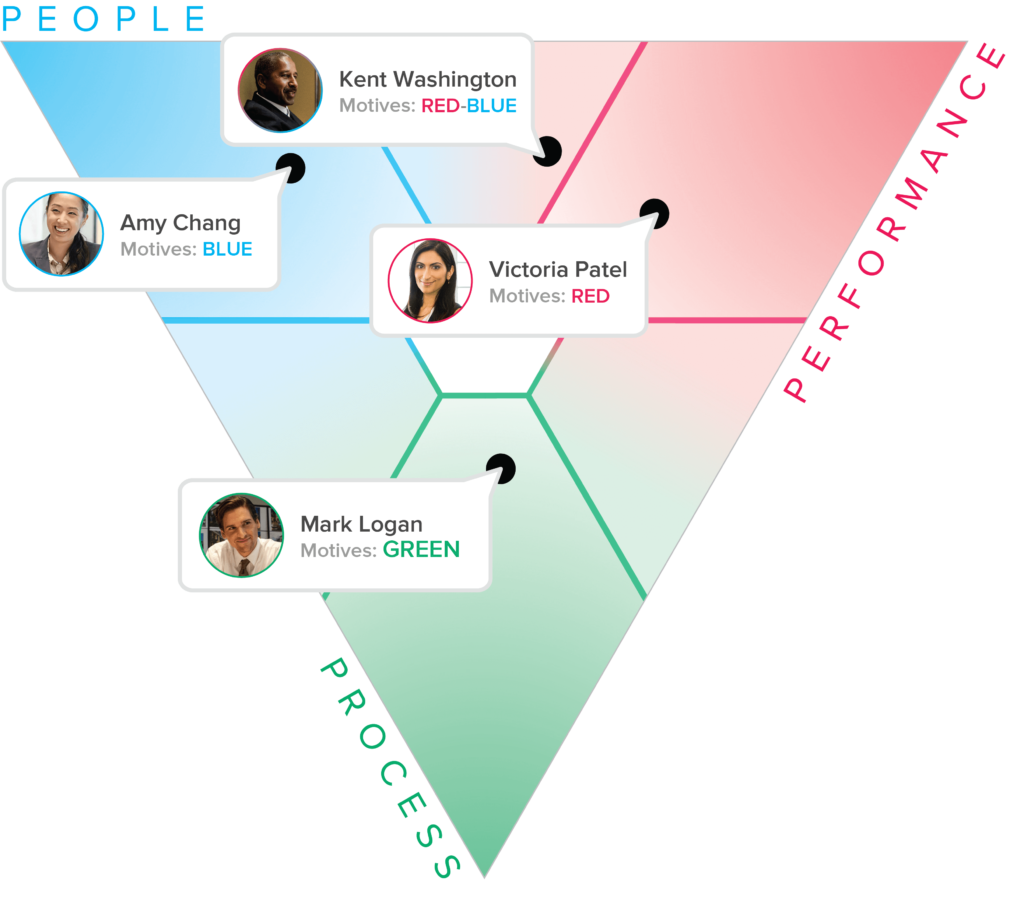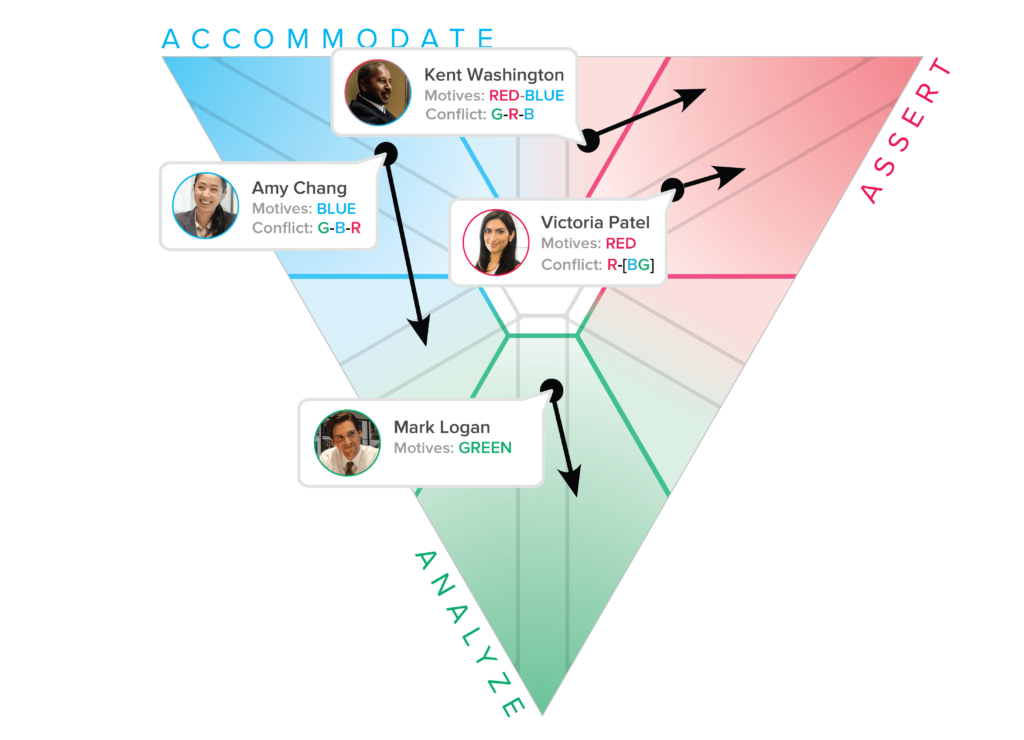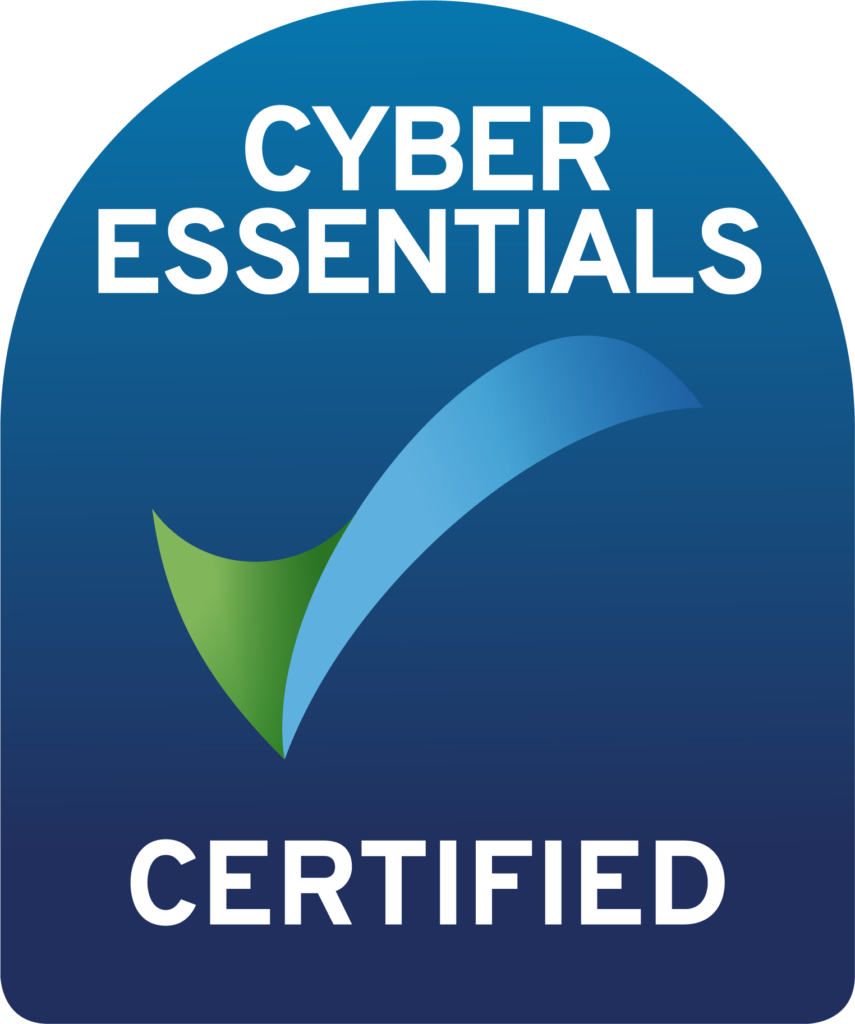The Power of the SDI 2.0
The SDI 2.0 (Strength Deployment Inventory) is a strengths assessment about you and how you relate to others. It measures your core motives, how you experience conflict, your strengths, and how strengths can be overdone, limiting interpersonal effectiveness. With these four views, it delivers personalized Relationship Intelligence (RQ) to help you and your teams build trust and form productive relationships.

Charting What Matters
You have a blend of three motives – People, Performance, and Process. These motives influence the way you approach your whole life. For some, being helpful and supporting others is at the forefront of their life and work. Others are more results oriented and they want to get things done better and faster than others. Some are more process oriented and they want to get things done right. Many are an even blend of the three.
Depending on your scores, the SDI 2.0 plots your motives as a dot and places it into one of seven regions on the SDI Triangle. These color-coded regions show how you prioritize the People, Performance, and Process motives at your core. We call this a Motivational Value System or MVS, and your MVS dot shows what intrinsically matters most to you when things are going well.

The SDI shows your blend of motives as a dot on the Triangle.

The SDI Triangle shows how your motives change in conflict
Conflict Changes the Game
Things don’t always go well. Sometimes there’s conflict in a relationship. This is what you feel when your motives and values are being threatened. It’s usually uncomfortable and you often don’t feel at your best. That’s because your motives predictably change in conflict, and we call that a Conflict Sequence. At some point in a conflict, you shift from a People, Performance, Process perspective, and you begin to focus on how to Accommodate, Assert, or Analyze the situation. Everyone predictably experiences those 3 stages of conflict (in varying order) and we show that change with an arrowhead in one of thirteen Conflict Sequence regions on the SDI Triangle.
Conflict and motives are closely related because you are more likely to go into conflict over things that are important to you. But the good news is, the SDI 2.0 shows you how to resolve conflict productively, no matter how bad it gets. In summary, your motives are represented by a dot on a color-coded triangle, and your Conflict Sequence is represented by an arrowhead that shows how your motives change during the three stages of conflict.
Strengths are for Strengthening Relationships
Your assessment results provide you with a Strengths Portrait that tells a story of how you use your strengths when you interact with others. The strengths measured aren’t skills or proficiencies, but the behaviors you choose when trying to reach a goal.
Your Strengths Portrait ranks your strengths from 1 to 28 and shows how you prioritize these behaviors in your daily work relationships. Some strengths energize you. Some don’t. The strengths at the top are most like you. You use the middle strengths less often. And you may be uncomfortable with the strengths at the bottom or even avoid using them. Your top strengths are often really effective for you, but sometimes your preferred strengths won’t work in certain situations or with certain people. But just because you prioritize certain strengths, does not mean you can’t use different ones. You have a choice.
How do you know if you’re using the right strength? Pay attention to your interactions. Are your strengths getting the intended results and reactions? Are you achieving your goals while making things better for others in the process? Choosing the right strength fosters collaboration and solidifies the bonds within your team.
Strengths can be Overdone
Almost everything you’ve heard about weaknesses is wrong. They’re not flaws or things you don’t do well. In truth, they’re strengths you overdo. To some, it looks like a weakness because it’s possible to have too much of a good thing. Overdone strengths are like good music played too loud. You do something expecting positive results, but you get a negative reaction instead. Your intentions are good, but they don’t always harmonize with others’ expectations.
Some people see your strengths the way you intend them, while others experience a distorted version. If you use a strength too much or in the wrong context, it won’t work as intended. And when you don’t get the expected results, you turn up the volume and try harder – overdoing it to the point of weakness. But you can make it a productive strength again by adjusting the volume, by doing less.
Your assessment results show the strengths you’re most likely to overdo at work, how others might misjudge you, and how you might misjudge them. The overdone strengths at the bottom of your portrait are what you would never want to overdo. When you see those undesirable overdone strengths in others, it can trigger conflict for you. But before you respond, be mindful that they are not trying to overdo it. Instead, try changing your perception. Suspend judgment and find their positive intent. And when your own strengths aren’t working as expected, bring a different strength that fits the context and works better for you both. Tone down your overdone strength by reducing the frequency, duration, or intensity. That’s how you turn it back into a strength.
SDI 2.0 Personal Report
Research based on
assessments
Based on a solid scientific foundation, the SDI 2.0 explains and simplifies the complex dynamics of relationships.

The SDI 2.0 Provides Visibility Into Team Relationships
Team Impact
Many strengths assessments provide good insight, but inevitably leave you with one big question – “now what?” The SDI 2.0 is actionable and memorable, and it positions that insight in the context of your daily team interactions. So you can actually use it and see it work in your meetings, messages, and conversations.
Best of all, the people who work together with you can see their results plotted in the context of your team. This aggregate picture of personality provides Relationship Intelligence (RQ) to everyone and makes it easier for your teams to understand each other’s strengths and know how to appreciate their differences. When your teams know what motivates each colleague, you can talk about why you see things differently. When diversity is seen as an asset, diverse opinions can lead to a breakthrough. And with visibility into team strengths, you can leverage everyone’s best for greater results.
Now in 17+ languages, the SDI 2.0 is a critical tool to help team members feel seen and valued so they can strengthen trust. It empowers managers to coach and grow talent. It gives your recruiters a lens for finding the right talent for the team. And when applied correctly, this Relationship Intelligence unblocks teams to move business forward.
How It Makes a Difference
No matter what the future of work looks like, people will always need to get along. They will still need to collaborate, understand each other, and communicate effectively. As jobs become more complex and strategic, relational competencies have become key differentiators, particularly for leaders. As you are promoted to more senior roles, your performance is measured not only on bottom-line results but also on how you manage your relationships with key stakeholders.
The SDI 2.0 helps you focus on how to collaborate, coach, and build high-performing teams that deliver on business goals. The result is team trust, reduced conflict, greater retention, and lasting change.
For more information about the science and history of the SDI 2.0 assessment, view the resources below.
Starting With the Why
While many tools focus on what we do, the SDI 2.0 goes deeper and helps you understand the why behind your behaviors. Established in 1971 and taken by over 5 million people, it shows who you are at the core and how that influences the way you work with others – when things are going well and when there’s conflict.
Because the assessment measures four unique views, your SDI 2.0 results are more than a snapshot, they’re a map. Your results are nuanced and personalized to who you are, how you can be the best version of yourself, and how you can make choices that strengthen your connection with the people around you.














